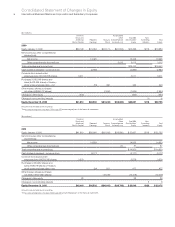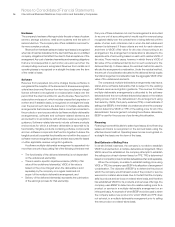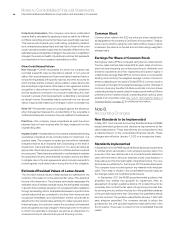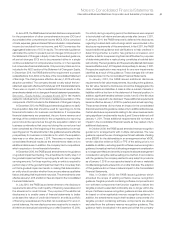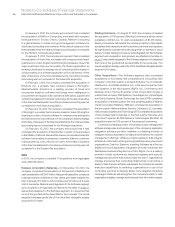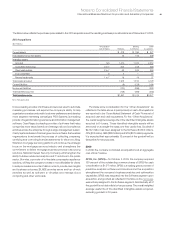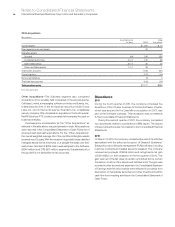IBM 2011 Annual Report Download - page 86
Download and view the complete annual report
Please find page 86 of the 2011 IBM annual report below. You can navigate through the pages in the report by either clicking on the pages listed below, or by using the keyword search tool below to find specific information within the annual report.
Notes to Consolidated Financial Statements
International Business Machines Corporation and Subsidiary Companies84
in accumulated other comprehensive income/(loss) in the Consolidated
Statement of Changes in Equity until the item that was hedged affects
earnings. However, when it is probable that a forecasted transaction
will not occur by the end of the originally specified time period or
within an additional two-month period thereafter, the net gain or loss
in accumulated other comprehensive income must be reclassified
into earnings immediately. The company reports cash flows arising
from derivative financial instruments designated as fair value or
cash flow hedges consistent with the classification of cash flows
from the underlying hedged items that these derivatives are hedging.
Accordingly, the cash flows associated with derivatives designated
as fair value or cash flow hedges are classified in cash flows from
operating activities in the Consolidated Statement of Cash Flows.
Cash flows from derivatives designated as net investment hedges
and derivatives that do not qualify as hedges are reported in cash
flows from investing activities. For currency swaps designated as
hedges of foreign currency denominated debt (included in the
company’s debt risk management program as addressed in note D,
“Financial Instruments,” on pages 96 to 100), cash flows directly
associated with the settlement of the principal element of these
swaps are reported in payments to settle debt in cash flows from
financing activities in the Consolidated Statement of Cash Flows.
Financial Instruments
In determining the fair value of its financial instruments, the company
uses a variety of methods and assumptions that are based on market
conditions and risks existing at each balance sheet date. Refer to
note D, “Financial Instruments,” on pages 93 to 96 for further
information. All methods of assessing fair value result in a general
approximation of value, and such value may never actually be realized.
Fair Value Measurement
Accounting guidance defines fair value as the price that would be
received to sell an asset or paid to transfer a liability in an orderly
transaction between market participants at the measurement date.
Under this guidance, the company is required to classify certain
assets and liabilities based on the following fair value hierarchy:
• Level 1—Quoted prices in active markets that are
unadjusted and accessible at the measurement date
for identical, unrestricted assets or liabilities;
• Level 2—Quoted prices for identical assets and liabilities
in markets that are not active, quoted prices for similar
assets and liabilities in active markets or financial instruments
for which significant inputs are observable, either directly
or indirectly; and
• Level 3—Prices or valuations that require inputs that are
both significant to the fair value measurement and
unobservable, including the company’s own assumptions
in determining fair value.
The guidance requires the use of observable market data if such
data is available without undue cost and effort.
When available, the company uses unadjusted quoted market
prices to measure the fair value and classifies such items within
Level 1. If quoted market prices are not available, fair value is based
upon internally developed models that use current market-based
or independently sourced market parameters such as interest rates
and currency rates. Items valued using internally generated models
are classified according to the lowest level input or value driver that
is significant to the valuation.
The determination of fair value considers various factors including
interest rate yield curves and time value underlying the financial
instruments. For derivatives and debt securities, the company uses
a discounted cash flow analysis using discount rates commensurate
with the duration of the instrument.
In determining the fair value of financial instruments, the company
considers certain market valuation adjustments to the “base valuations”
calculated using the methodologies described below for several
parameters that market participants would consider in determining
fair value:
• Counterparty credit risk adjustments are applied to
financial instru ments, taking into account the actual credit risk
of a counterparty as observed in the credit default swap
market to determine the true fair value of such an instrument.
• Credit risk adjustments are applied to reflect the company’s
own credit risk when valuing all liabilities measured at
fair value. The methodology is consistent with that applied
in developing counterparty credit risk adjustments, but
incorporates the company’s own credit risk as observed
in the credit default swap market.
As an example, the fair value of derivatives is derived by a discounted
cash flow model using observable market inputs such as known
notional value amounts, yield curves, spot and forward exchange
rates as well as discount rates. These inputs relate to liquid, heavily
traded currencies with active markets which are available for the
full term of the derivative.
Certain financial assets are measured at fair value on a nonrecurring
basis. These assets include equity method investments that are
recognized at fair value at the end of the period to the extent that
they are deemed to be other-than-temporarily impaired. Certain
assets that are measured at fair value on a recurring basis can be
subject to nonrecurring fair value measurements. These assets
include public cost method investments that are deemed to be other-
than-temporarily impaired. In the event of an other-than-temporary
impairment of a financial instrument, fair value is measured using a
model described above.
Accounting guidance permits the measurement of eligible
financial assets, financial liabilities and firm commitments at fair value,
on an instrument-by-instrument basis, that are otherwise not permitted
to be accounted for at fair value under other accounting standards.
This election is irrevocable. The company does not apply the fair
value option to any eligible assets or liabilities.


